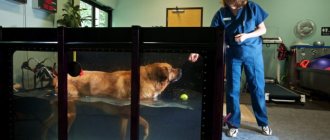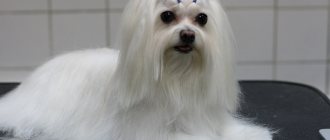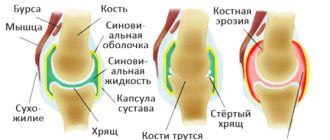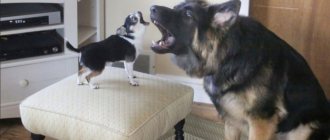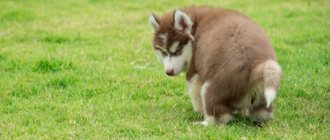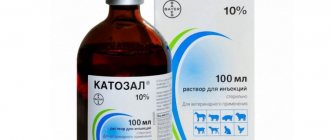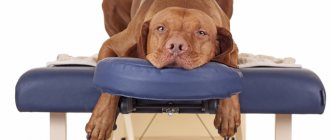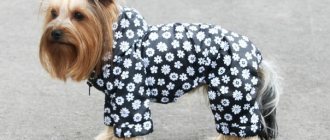Exercises for dogs. Loads for the dog.
(Part 2). Two main rules of training. As with any person, with dogs, cats, horses, and all animals in general, when it comes to exercise, two basic rules apply. The first rule can be called the “Rule of Two Ps”. It's about consistency and consistency.
By “Sequence” we mean that all physical exercises begin with the easiest, preparatory variations, and the load increases gradually, taking into account the physical condition of the dog and its physical capabilities. That is, you start with the easiest option, and only when the dog copes with it “Excellently”, do you complicate it and increase the resulting load. “Excellent” means that your dog is comfortable, shows no signs of fatigue, and is generally alert and cheerful. Only if the dog looks tired, broken, and works without enthusiasm, there is a high probability that it cannot cope with the current level of load, and there is nothing to talk about moving to the next one. By “Consistency” we mean that if you want to achieve results, then your exercises must be constant, that is, performed according to a strict schedule. Let's say three times a week. A scenario where a dog kicks its tail in the apartment all week is completely unacceptable, and on the weekend you break out into a cross-country run with it. Evenly and constantly, it is desirable that there be equal intervals between training sessions, and that it really be a schedule, that is, “This Week Once, and Next Week We’ll Work Four” - this is very bad. The second rule is “Remember to Warm Up.” Before you start training, play a ball with your dog for 5 minutes (just a ball, don’t throw it too far) or run for 10 minutes and let your dog warm up. After your training has come to an end, a good solution would be to give your dog a “Cool-down” - a run at a calm pace or a fast walk, about 5 minutes. So, we remind you: warm-up at the beginning, cool-down at the end, consistency and consistency. Only if you cannot follow these simple rules, it is better not to start doing anything at all. By the way, this applies equally to people - if fitness trainers read us, I think they will agree with me.
And one more thing: dogs that receive stress on a regular basis eat food from the “Active” line, or, if you are on a natural diet, you create a diet taking into account the loads they receive. When training a dog may be contraindicated. It is quite obvious (I hope) that for dogs with any health problems, the stress is immediately removed and does not continue until the veterinarian says: “Let's go!” With any deviations, this means that even if your dog just has a cold, he does not receive any stress, he has “Exemption” from physical education for the period of illness and a week after, everything is like with people. After injuries, after vaccinations, after any manipulations with the participation of a veterinarian - in all these cases, the load is temporarily limited. But only temporarily. As your dog recovers or is on the mend, you gradually return to your normal pace of exercise. A little less obvious to owners is that strength training and heavy cardio are not recommended for puppies under one year old and older dogs. They are not even undesirable, but practically contraindicated. That is, run with a person - please. But running faster than the average person runs (that is, a bicycle, etc.) is already unnecessary. Carrying tires, sleds, or carrying anything at all - no! Jumping, galloping, any sport that involves stress on the joints - no! This is explained very simply: puppies begin to change their teeth at about three to four months, and, as a rule, it is from three to four months to a year that the phase of intensive growth occurs. In older dogs, the joints are simply not as strong as in young animals. Thus, if you are not a professional with years of experience in sports and physical therapy with dogs, don’t interfere, let the dog’s body grow and develop on its own. It is extremely easy for unbalanced loads to break the entire dog and ruin the joints. To be fair, it is worth noting that it is also impossible to avoid any stress at all during the period of growth, because the joints need them for normal development. But by load in this case we mean simply running with a person. Without unnecessary additives, without bicycles, the dog does not drag the owner on a leash, but runs freely. As an option - active games, but, again, without jumping and pushing with the paws, without unnecessary stress on the joints. Swimming is recommended for all dogs of all ages. As much as you like. Running in deep snow (where the dog has to make his way) too. Cardio exercises for dogs. Actually, natural cardio for a dog is running. We pay special attention to the fact that dogs do not wear sneakers, and their pads are not intended for constant running on asphalt. Yes, your dog walks every day, including on the asphalt, but running is not an ordinary walk, you will simply rub the dog’s paws bloody. Run in park areas or anywhere where the dog can run on grass, dirt or snow. Running can be an "Easy" version, which is simply running with a person: for most medium-sized dogs this is not very strenuous. You can start running from a very young age, and you definitely need to teach the puppy to run next to you (the main thing is always on one side, and not wag in front of you on a leash. Attention! Only in case you have forgotten, the maximum time for such a load for a puppy is his age in months multiplied by five (10 minutes for a puppy of two months, 15 minutes for a puppy of three months, etc.
Running next to a person is the only exercise that you can give to a puppy during the period of teeth change and in the phase of intensive growth, as well as to older dogs. With great care, observing how the animal feels, completely excluding jumping and sudden jumps. The next stage in difficulty will be running downhill, that is, running uphill. This is already quite difficult for a puppy, and it is better not to do this with puppies until at least eight months. The closest analogue of this type of load would be running up the stairs, which, for the same reasons, is contraindicated for puppies and older dogs. If your puppy at most goes down from the first floor when he goes outside, this is normal, but if he runs several flights of stairs every day, this is a very, very serious risk. If you live even on the second floor, either carry the puppy in your arms or take the elevator to the first floor. For healthy adult dogs, running uphill is very beneficial (of course, if you start gradually and do not immediately climb a sheer cliff.
Another running option is running behind a bike. Please pay attention: behind the bicycle or next to the bicycle, but not the option where the dog drags this bicycle, because working with weights is no longer just cardio. Start with a kilometer at an average pace and gradually increase the distance, adding, for example, 500 meters every week - two depending on how often you exercise and how well your dog maintains the current load. This type of exercise is also contraindicated in dogs under one year of age. All games with a dog from the “Run after the Ball” series are a so-called explosive load. We also turn it on only after eight months, and gradually. No, rolling a ball on the floor or throwing something a couple of meters away (in an apartment, for example) is not the same, even a puppy can do this. We are talking about those games where a ball or plate is thrown as far as you can throw it, and the dog immediately rushes after the thrown object. You don't need to play games like this with puppies. You should also be very careful with older dogs: only those dogs that led an active and healthy lifestyle in their youth can afford this kind of stress without compromising their health. Start with three to four throws. Gradually increase until you reach, say, fifteen. Nothing more is needed. And, as a reminder: swimming is possible for everyone! Strength training with a dog. By power, we most often mean those types of loads where the dog works with weights: dragging a sled, dragging a tire on a harness, or, for example, dragging something on wheels (such as a stroller or bicycle), this also includes towing a skier , as well as canicross. All this is a professional canine sport, each version has a countless number of small nuances. Important! This article is not about professional sports at all: if you want to seriously engage in Veit - pulling, riding sports, bike - joring or kani - cross, then you should look for a community of professionals in your city, where you will get detailed information, and most importantly, in practice , will show you how to properly prepare your dog for this. How to use equipment, how to choose it correctly and fit it to your dog, how to plan loads - the instructors will tell you all this. I will not undertake to give universal recommendations here for one simple reason: universal recommendations do not exist. Each case is unique because each dog has a unique set of starting characteristics, “Toolbox” (breed), temperament and health. What works for one may cause disability for another. Literally. Thus, if you are an adequate and healthy person, you will not learn serious sports from articles on the Internet and experiment on your dog. But what if winter has come and you just want to harness the dog in a sleigh and, for example, take the children for a ride? Actually, nothing new. Buy a harness and gradually begin exercising your dog, very carefully increasing the weight. Start with a kilometer, and there should be nothing on the sled that weighs more than the average child under 10 years old. Over time, increase the distance, and even later you can increase the weight, but I’ll say right away: if you don’t live in a region where winter lasts most of the year, you shouldn’t expect that in one winter you can bring your dog to such a state that he will be able to carry a sled with an adult alone without any problems. It will take more than one or two months of constant training for a dog to drag an adult man without harm to its health. So, if you want to ride a dog, I’m afraid you should go to sled-sport instructors. The same applies to any sport where the dog needs to pull something. This kind of stress is either a professional sport or completely unnecessary for your dog. Another common practice is to load dogs with special weights on a harness in order to “Build Up Relief.” Perhaps this seems funny and beautiful to some, but about perversions of this kind you should, first of all, remember the following: these are unnatural loads for a dog, for which the animal, most often, is simply not suited. This is unnecessary, completely unnecessary, most often people just amuse their vanity with this. I can advise these people to realize themselves independently, and not at the expense of their animals. Go to the gym and build some muscle for yourself, by God. There will be more sense. Too much load. Certain signs will let you know that your dog is tired and whatever you are doing needs to stop and give your dog a break. After the exercise, these signs indicate that you have overtrained the dog, and next time the load should be reduced. These signs include: * very heavy breathing during or after exercise; * strong thirst;. * any lameness or hesitancy when performing movements that the dog previously did without problems; * the dog looks extremely tired and sleeps longer and more often than usual; * the dog does not want to go anywhere, goes for a walk without enthusiasm and does not play with you; * the dog “freezes” during the process and does not follow even those commands that it knows very well. If your dog exhibits any of the above, it is likely that he is very tired and you have overdone it. At any age and in any condition, a dog or a person can play sports. Only the intensity and variety varies. The main thing is to follow the rules: warm-up, cool-down, consistency and consistency. Remember that any sport and exercise, with the exception of cases when it comes to physiotherapy and rehabilitation, should never be forced on a dog, it should bring pleasure to the dog, not suffering. We hope that your desire to exercise with your dog is dictated solely by concern for the health of your pet, and not by attempts to assert yourself at the expense of your dog. Only if the goal of your exercise is health, joy and spending time together, you will not pursue results to the detriment of your health and the health of your pet, you will simply enjoy the process. A little later, when we manage to catch our athletes and interrogate them with passion, we will try to tell you more about the various types of canine sports, but for now - good luck to you in your sporting endeavors, and happy holidays! dogsfordarticles.
Why do you need fitness for dogs?
Many dogs suffer from physical inactivity (lack of movement), because dogs often sit in the apartment all day, going out for a walk only on a leash. Consequences of physical inactivity:
- Metabolic disorders, obesity.
- Diseases of the musculoskeletal system.
- Cardiovascular diseases.
- Destruction of the animal’s nervous system, problematic behavior.
- Deterioration of the body's overall resistance.
- Reduced lifespan.
A study was conducted in Western countries that identified factors influencing obesity in dogs:
75% - imbalance between energy consumption and energy consumption, i.e. The dog eats a lot and walks a little.
14% - excessive food consumption in combination with active walks, i.e. the owner, believing that the dog leads an active lifestyle, excessively increases the calorie content of the diet.
10% - chronic diseases.
1% is a seasonal factor (in summer the dog does not need to spend energy heating its own body).
The research also revealed a relationship between the level of physical activity and the occurrence of diseases.
| Study subjects (total 2241 people, each owner of 1 dog) | Walking dogs on a leash in the warm season | Diseases due to insufficient physical activity in the warm season (out of 2241 dogs) – 35%. |
| Living in urban (apartment) conditions (1099) | 300 minutes per week (40 minutes per day) | 20% |
| Residents living in the private sector within the city (652) | 150 minutes per week (20 minutes a day) | 11% (5.5% - free range, 5.5% - aviary keeping) |
| Residents living in the private sector outside the city (490) | 460 minutes per week (65 minutes per day) | 4% |
The same dogs were then studied in the cold season, and the results differed.
| Study subjects (total 2241 people, each owner of 1 dog) | Walking dogs on a leash in the cold season | Diseases due to insufficient physical activity during the cold season (out of 2241 dogs) – 57%. |
| Living in urban (apartment) conditions (1099) | 200 minutes per week (28 minutes per day) | 43% |
| Residents living in the private sector within the city (652) | 100 minutes per week (15 minutes a day) | 10% (2% - free range, 8% - aviary keeping) |
| Residents living in the private sector outside the city (490) | 300 minutes per week (40 minutes per day) | 4% |
Free walking is not enough for the proper development of a dog, although it does provide physical exercise. Physical activity is any bodily movement produced by skeletal muscles that results in energy expenditure. But proper distribution of energy in a dog’s body is possible thanks to thoughtful, systematic, monotonous physical activity. And free walking allows the dog to independently distribute the load on organ systems, training some and not using others. An imbalance in the body's trained systems leads to injury and illness.
Fitness for dogs is a health-improving technique that allows you to change the overall physical fitness of the animal’s body, prevent a number of diseases, improve the psycho-emotional state of the dog, correct some exterior defects and breeding errors, work on the animal’s weight, restore the pet after illness, injury, surgery and permanently consolidate the achieved results. result.
Good physical fitness includes:
- Preparedness of the cardiovascular system and musculoskeletal system.
- Flexibility.
- Muscular endurance.
- Strength.
- Development of a sense of balance.
- Good coordination of movements.
- Reaction.
- Speed.
- The ratio of muscle and fat tissue in the body.
In the photo: fitness for dogs
Dog exercises for hind legs. Exercises for show dogs on stable surfaces
Single-level exercises: statics with handling elements:
Exhibition stand in one plane for a time (from 30 seconds to 2 minutes). Use a stopwatch or set a timer and control the dog in the stance. This is very tiring for the dog, so if the pet can stand for 2 minutes, you have achieved great success. The pet can be fed at this time.
Multi-level exercises: active muscle contraction
- Squats (30 seconds to 1 minute). In terms of quantity, be guided by the dog’s capabilities. The height of the second level is the height of the hock or carpal joint (the front legs stand on an elevation). If the height is greater, the dog will experience discomfort, and the training will no longer be for active muscle contraction, but for stretching. The pace of squats should be as slow as possible.
- Push-ups (30 seconds to 1 minute). This time the hind legs are on the elevated surface. The height of the step is the same as for the previous exercise. You can guide your dog with a treat to help him do push-ups correctly. When doing push-ups, the dog's elbow should be directed along the body.
Multi-level exercises: coordination load
Climbing to the surface (from 15 seconds to 1 minute). Steps are used (approximately 6), but not a slide. Speed is not important, but it is necessary to maintain a fairly slow pace both when ascending and descending. The height of the step is approximately equal to the height of the hock joint.
The volume of loads depending on the age of the dog
| Dog age | Loading for the dog |
| 2 – 4 months | Play loads, massage, kinesio taping. |
| 4 – 6 months | Swimming, walking, working on balance pads, massage, kinesio taping. |
| 6 – 9 months | Swimming and walking with therabands, work on balancing equipment, power stretching, basic endurance training, massage, kinesio taping. |
| 9 – 12 months | All of the above + sprint uphill. |
| 12 months and older | All of the above + barriers, cavaletti, weighted aports, light weights of encircling weights. |
In the photo: fitness for dogs
Dog fitness exercises to strengthen your puppy's back. 3 types of basic fitness for show dogs
1. On stable surfaces (anything that does not wobble). It is very difficult for a dog to be stationary, so if you have success with working on stable surfaces, that's great, but you need to move on and include other simulators in your work. Exercises can be:
- Single-level: static with elements of handling (for example, an exhibition stand on a flat surface for quite a long time).
- Multi-level: active muscle contraction, coordination load.
2. On special unstable simulators (anything that wobbles). Exercises can be:
- Single-level (statics with handling elements, coordination load). The height of the machine should not be higher than the dog's wrist joint. This could be a sofa pillow, a mattress, etc.
- Multi-level (active training of deep muscles).
- Multiaxial (strengthening small muscles, articular-ligamentous apparatus).
3. On mixed simulators (a combination of both). Exercises are divided into:
- Single-level (static with elements of handling).
- Multi-level (active work of all muscle groups, strengthening of the joint-ligamentous apparatus).
It is important to include “switching” loads in your training! You cannot do several exercises aimed at one part of the body in a row.
There are exercises aimed at working the muscles and joint-ligamentous apparatus, and there are exercises that work the show trot itself (mainly cavaletti - bars that are at a certain height and distance from each other, a minimum of 4 bars and a maximum of 20 - 5 times 4).
“Switching” loads are needed after every 3 exercises. Those. We worked on the chest, back, neck - “switched” to working on the trot. We worked some more and “switched” again.
You can use gymnastics sticks as slats for cavaletti, or you can use improvised material (for example, sticks from brooms or mops - whatever you find at home). You can lay them out on books to create the desired height. The main thing is that they are not traumatic, i.e. so that the dog can easily knock them down with his paw in case of a mistake and not harm himself. If the slats are static, there is a high probability of bruising or other injury.
The distance between the bars for a comfortable trot is equal to the distance from the shoulder-scapular joint to the hip joint of your dog.
The height of the bar should not be higher than the dog's wrist joint.
“Switching” loads also work well for coordination. For example, you ran 4 cavaletti bars, turned around and ran them in the opposite direction - this is how the dog learns to “carry” itself around turns. You can offer turns around your axis both on a stable surface and on an unstable simulator.
Types of exercise in fitness for dogs
Aerobic (cardio) exercises help train the heart muscle, increase the stroke volume of the heart, improve endurance, and increase speed. These include:
- Walking.
- Different types of running.
- Hill sprint.
- Swimming.
Anaerobic (strength, energy-volume loads) contribute to the development of mobility, improved coordination and stability, increased strength, and muscle building. These include:
- Balancing projectiles.
- Cavalletti and hurdles, which came into fitness for dogs from equestrian sports.
- THERABAND-training (expander bands).
- Training with encircling weights. This does not mean putting a vest with lead weights on the dog or tying a splint to a riding harness - such a load is very harmful. Girdle weights are a type of cuff that, when tied correctly and at the correct weight, provide the correct load on the animal's muscles.
- Training with weighted aports. This training is very difficult to do correctly, and it is also difficult for the owner to determine whether it is worth giving the dog such training.
Passive (external loads) help to increase blood circulation, increase the production of serotonin, maintain (or re-develop) joint mobility, reduce the formation of edema, and prepare the animal for other types of load. Passive loads include:
- Power stretching.
- Massage.
- Kinesio taping is the gluing of tape-plasters with a special structure along certain lines to certain areas of the animal’s body. This provides either relaxation or tension in the muscles and ligaments.
In the photo: fitness for dogs
Exercises for dogs. Anatomy of the back muscles in dogs
The back muscles include the muscles of the spinal column - the cervical, thoracic, lumbar and caudal regions.
Almost all of these muscles belong to the dorsal muscles of the spinal column - that is, they are attached to the vertebrae from the back. Only some muscles of the neck are attached ventrally (from the abdomen), which perform the function of turning the neck to the sides.
The back muscles are formed by several layers of muscles.
The superficial layer of the neck and back muscles is formed by the splenius capitis muscle. It runs from the level of the atlas wing (the first cervical vertebra) to the spinous processes of T3 - T4 (thoracic vertebrae). With its participation, bending of the neck, raising and straightening of the head occurs. It is partially involved in the rotational movements of the neck.
The middle layer is formed by the iliocostalis and longissimus muscles. These two muscles completely fill the space between the spinous and transverse processes of the vertebrae from the occipital bone to the sacrum. The longissimus muscle, depending on the place of attachment, can be divided into sections - the longissimus muscle of the head, neck, chest, and lower back.
The deep layer includes the semispinalis and spinalis muscles and the multifidus muscles. The multifidus muscles are multi-layered, connecting every two vertebrae in series, the next layer connecting the vertebrae through one (the first and third), and another layer connecting the vertebrae through three (the first and fifth).
The muscles of the back also include short muscles - the intertransverse, interspinous and rotator cuff muscles.
The most mobile areas in dogs are the cervical and lumbar regions. The thoracic spine is less mobile, limited in the amplitude of flexion and twisting, the vertebrae are additionally stabilized by the ligamentum flavum. Therefore, most often injuries or disease of the intervertebral discs are diagnosed in the cervical or lumbar regions.
For the muscle group that rehabilitation therapists or athletes work with, there is a collective name “paraspinal muscles”. This group includes the multifidus, semispinalis and spinalis muscles, and partly the longissimus muscle. Exercises for the cervical spine are discussed separately.
Motives
Let's consider the motives of a dog's behavior that are convenient for their use.
- Desire to communicate with the trainer
- Food
- Production
- Avoiding discomfort
The desire to communicate with the trainer is the background for working with the dog and does not need any special comments. Without this, it is difficult to keep the dog’s attention or correct its behavior through mechanical influences. At a minimum, the dog must trust its handler.
Food
Food is convenient for work because the level of motivation is easily regulated by abstinence; in addition, food is easy to dose, introduce into a situation and remove from it.
Production
Prey is understood as various types of toys that the dog strives to catch up with, grab, possess and fight for. The advantage of toys over food is that a dog with a developed prey motive, when using them, works more dynamically and, when receiving a toy as a reward, experiences stronger positive emotions, which leads to faster learning. However, training through prey is technically a little more difficult, since the dog is more active and greater speed and accuracy are required from the trainer. An additional benefit from working with a toy is that the motive is constantly used and developed, which is then used in protection training at the first stage.
Avoiding discomfort
This motive is the basis for using influence on the dog with your hands and a leash. Allows you to adjust the position of the dog’s body in space and its actions in a situation where the dog is not interested in food and prey. Additionally, some actions are simply easier to initiate through mechanics.
Spinal walking exercises for dogs. Pathological physiology
Ruptures, most often observed in injuries, have more serious consequences, since in this case there is an actual violation of the integrity of the nervous tissue, that is, a truly complete injury. The prognosis for functional recovery from injuries of this type in animals with complete functional dysfunction of the spinal cord is more cautious. In some cases, surgical treatment of the underlying disease is not feasible due to financial limitations of the owner or other medical conditions. For example, after an injury that causes a spinal fracture, the animal may develop severe arrhythmia that prevents long-term anesthesia, or the owner may not be able to afford surgical stabilization. In such cases, recovery from rehabilitation is still possible as long as there is no further damage. The underlying mechanisms of subsequent injury include instability leading to repeated concussion and spinal cord compression, and ongoing severe spinal cord compression. However, spinal instability can be managed with simple external splints and treatment, but the physiotherapist should always be aware of the risk of further injury. In addition, the effect of ongoing compression of the nerve roots at their exit from the intervertebral foramina should always be taken into account. Nerve root compression can cause severe pain and be a limiting factor in the treatment of such cases.
What dogs need fitness and why?
- For dogs with a sedentary lifestyle living in urban environments, to prevent complications of congenital diseases.
- For dogs with behavioral problems to strengthen the psycho-emotional state and nervous system.
- For show dogs to correct the exterior and achieve “peak form” for exhibitions.
- For working dogs and sports dogs to prevent injuries when preparing for competitions.
- For puppies to form correct anatomical development during different periods of growth and strengthen the body’s overall resistance to external factors.
- For older dogs to improve their quality of life and improve their health.
- Pregnant bitches to prepare for childbirth without complications and quickly recover after.
Dogs, like people, are divided by temperament into choleric, sanguine, phlegmatic and melancholic.
Many people call choleric people hyperactive, but I would not make such a diagnosis. Cholerics have 3 levels of activity:
- Low: quick reaction, courage, speed in remembering commands.
- Average: sharpness, rapidity of movements, strength, impulsiveness, pronounced emotional experiences, problems in remembering combinations of learned commands.
- High: neuropsychic activity, aggression, lack of emotional and motor balance, incontinence, hot temper, inability to self-control under emotional circumstances. Such dogs need, first of all, adjustments with the help of an animal psychologist, and only then, on the recommendation of an animal psychologist, can they proceed to fitness classes.
The impact of dog fitness on the functional state of a choleric dog:
The functions of the nervous system are improved, the strength of the processes of excitation, inhibition, their displacement (mobility) and balance increases, which ensures more perfect regulation by the nervous system of all other organs and systems of the body.
The force of contraction of the heart muscle increases, blood supply significantly improves, and with it the nutrition of tissues, organs and systems.
The composition of the blood changes, which ensures an increase in its oxygen capacity and an increase in its protective properties.
The activity of the respiratory organs becomes more economical at rest, and reserve capacity decreases at maximum loads. That is, at rest, shortness of breath disappears.
Metabolic processes are improved, energy substances in the muscles are consumed more actively, the oxidation of breakdown products occurs faster and more completely, and the removal of metabolic products is accelerated.
In the photo: fitness for dogs
Exercises to strengthen your dog's hind legs. Exercises to develop and strengthen a dog’s hind legs
- Stand on hind legs. Executed by the “serve” command. In order for the dog to rise on its hind legs, you can lure it with a piece of treat (for example, a dog food pellet). The number of repetitions and duration of standing must be increased gradually. For the first time, time how many seconds the dog stands, then each time add a second for repetition. You can start with three executions of the “serve” command.
- Jumping up can be done by tossing a dog object or luring it with a treat. The dog needs to swim so many times until he gets tired.
- Swimming. If you have access to ponds in the summer or to a pool year-round, exercise in the water will perfectly help strengthen the muscles of the limbs. The activity should be in a playful way. You can throw a stick or ball into the water and command them to bring it back. You don’t need to throw it far right away until you are 100% sure that the dog can swim to the shore on its own. With each workout, gradually increase the distance for swimming and the number of times.
- Running uphill. It is carried out in the same way as swimming in a playful way, by throwing the dog’s favorite object up the mountain. The dog must bring it every time. Repeat as many times as possible until the dog gets tired.
- Climbing stairs. You can walk with your dog together in a multi-story building. But the best option would be a long city staircase, for example in a park. The exercise is carried out in the same way as running uphill. The owner throws a dog toy up the stairs, the dog runs after it and then returns it to the owner. Then the item is thrown again.
Exercises for an adult dog
Young dogs are considered to be animals between 2 and 8 years old. Walking on a leash and swimming can provide sufficient physical activity. Exercises for small breed dogs in this age range should be aimed at maintaining muscle tone.
This approach will protect tendons and ligaments from microtraumas that are so common in small animals.
Some people mistakenly believe that a win-win option in this regard for small dogs is walking without a leash, when the animal sets its own pace of movement.
In fact, according to research by leading American dog trainer Rachel Paige Elliott, the muscle corset develops best when taking regular walks on a leash, but using different paces of movement. This is due to the fact that when running in “free flight”, the animal loads its body to a minimum, since by its nature it is very rational both in actions and movements.
For adult dogs, time should be allocated for morning and evening walks of at least 15 minutes. When walking a dog on a leash, you should move at such a pace that the animal moves at a fast trot without stopping. In addition to developing the muscle corset, this exercise creates an aerobic load aimed at maintaining the functioning of the cardiovascular system.
Walking exercises
Before starting physical exercises, it is worth giving the animal the opportunity to walk on its own in order to relieve itself and run a little in a mode convenient for it. Interesting fact: in order for a male dog to completely empty his bladder, he must raise his paw 10 to 12 times while walking.
Classes for small dogs should not be complicated by difficult tasks. Long runs over long distances should be replaced with a set of several short-term exercises.
- Apportation is an exciting game based on the commands “search/give/fetch”. It is aimed at teaching the animal to grab and return the retrieval object to the owner. To involve your dog in this idea, you must first draw attention to the toy and then throw it a short distance away from you. When the dog grabs the object, force him to release the burden from his mouth. To do this, bring your open palm to your muzzle and say a confident “give.”
- Movement on an inclined surface. During this exercise, the muscles of the hips and shoulder girdle work well, but joints and ligaments may suffer. To minimize the risk, the inclined surface should be used specifically for lifting to the top. It is better to go down the slope as gentle as possible. If the animal wants to speed up the pace, allow it to do so.
- Shallow water games. Running in low water develops the muscles of the back and forearms well, but the risk of injury to the animal’s joints is reduced to zero. In addition, swimming and playing in shallow water teaches the animal to breathe with its mouth closed. If the dog is initially afraid to go into the water, you should not deliberately push it. It’s better to first throw your favorite toy near the water and go ankle-deep into the water yourself - the dog will be wary at first, but then will happily follow the owner.
Any physical exercise should please the animal and not exhaust it. When selecting tasks, remember that during training, the heart should not be subject to excessive stress.
Puller games
When conducting training for small dogs, it is convenient to use a puller. The training projectile in the form of a ring flies well and rolls on the ground, does not sink in water. It is convenient for the animal to take the puller in its teeth without fear of injuring its teeth and gums, or to wear it around its neck. For small breed dogs, you should choose products “S” size D19 cm. They are produced in the form of sets of two identical rings in bright colors.
Exercises using a puller:
- Throw or launch the ring along the ground. The dog will happily chase it and bring it back.
- If the dog grabs the ring tightly, try to lift the projectile off the ground along with the “trailer”.
- A game of ring tug-of-war between dog and owner. In a fit of excitement, a dog may growl, but this is not a manifestation of anger.
When working with this simulator, remember that the puller is not intended for the dog to play independently. You chased your pet on the street, came home - put it out of sight.
Exercises for dogs for the back. Dog fitness: six basic exercises
Recently, the topic of physical development of dogs has become very popular. Most owners have heard that dogs can use special exercises to strengthen their muscles to maintain health. Therefore, many people want to try dog fitness with their dogs. You can find many exercises online, ranging from simple to very complex, that are only suitable for advanced dogs. Very often I am asked about where it is better to start, and what exercises are suitable for beginners.
First you need to go to the vet and check if your dog is healthy and ready for the stress that you are going to give it. If you have the opportunity to visit a veterinarian-physical therapist, I recommend consulting with him to make sure that the dog's health condition allows it to perform exercises. So, if your dog is healthy and your veterinarian has allowed you to do dog fitness, then you can start exercising. Where is the best place to start?
Below you will find 6 basic exercises. They are suitable for almost all healthy dogs (again, check your dog’s health with a veterinarian). Once your dog has mastered these 6 exercises, you can continue doing them, but you will need to increase the difficulty level.
Rules that are important to remember:
- Work slowly, this is not a race. You need to make sure that the dog does not harm itself.
- Quality is more important than quantity! Many thanks to Debbie Torraca at Wizard of Paws for constantly reminding us of the importance of quality.
- Watch for signs of fatigue. If you see them (the dog turns its elbows inward or, conversely, outward; position in a half-squat, etc.), then stop the lesson immediately!
1. The most important exercise is standing balance. Start working on a standing position on a flat surface for 30 seconds. The dog must stand still, without shifting its weight, changing position (sitting down), or moving its paws. It's not as easy as it seems! This exercise is the foundation for everything else in fitness, so give it plenty of time and don't rush it! When standing on a flat surface no longer poses a problem, try adding an unstable surface. This could be a bulky dog bed or a special balance pad.
2. Change of position: sit-stand and stand-sit. Teaching your dog both types of shifts is very beneficial. The fact is that when changing position on the hind and front legs, different muscle groups work, and this requires different skills. Pay attention to whether the hind or front legs remain motionless. a) Change on the hind legs. With this shift, the dog puts its weight on its hind legs when sitting down, and when it gets up, it moves forward. b) Change on the front. When a dog sits down, it pulls its hind legs towards its front legs, and when it gets up, its front legs remain in place, only its hind legs move.
3. Walking backwards Walking backwards, rather than hopping like a hare, is a great exercise. Firstly, it shows well how the dog moves, and you can see many of the nuances when moving backwards. When moving backwards, it is better to reward the dog closer to the ground so that his topline remains natural.
4. Head up! We teach the dog to raise its head while standing. This is a very useful exercise for the core muscles. First, the dog must learn to do exercise #1 (standing balance). When the dog is in a standing position, take a treat and lure the dog so that his head lifts slightly up. When a dog raises its head, the core muscles contract and automatically more weight is transferred to the hind legs. Do this several times in a row. The dog in the photo is experienced, this is not its first activity.
5. Weight transfer Standing balance (see point 1) is the basis for this exercise. Apply light pressure with your open palm to your shoulder, hip, or both. You can gently press on the chest. The force with which we press with our palm must be selected in such a way that the dog does not move from its place, and, of course, we cannot push it so that the dog falls! We need the body not to move, but the muscles to work intensely!
6. Raise your paw! This is “Give me your paw” from a standing position! Yes, again it's all about standing balance. Teach your dog to lift his paws one at a time, ideally both front and back. While one paw is in the air, the rest must remain motionless. To make this exercise more challenging, you can use unstable surfaces.
Remember: each exercise must be performed slowly and carefully. Do not hurry! And please make sure that your dog enjoys dog fitness exercises!
Why should your dog exercise?
Dog fitness is a modern fashionable popular trend.
Dog fitness solves several problems:
- strengthening body muscles to maintain health;
- building muscle mass to improve sports and exhibition performance;
- rehabilitation after illness;
- for preventive purposes if the pet is susceptible to certain diseases.
Before you begin to intensively train your pet, you should consult with your veterinarian about physical health and readiness for increased stress.
Before starting training, you must consult a veterinarian
Before moving on to specific activities, it is necessary to note that:
- they need to be performed slowly so that the dog has time to rest; the number of exercises and repetitions should be increased gradually;
- increase the load and duration of classes gradually;
- The emphasis should always be on quality, not quantity (it is better to do few repetitions, but correctly, than many but not of good quality);
- carefully monitor your pet’s condition during training (its well-being and degree of fatigue);
- It is strictly forbidden to force the dog to do exercises, to shout at him during exercise, and even more so to hit him;
- It is imperative to reward your pet with treats, praise and stroking or hugging;
- All classes should be conducted in an incentive form.
Exercises for small breed dogs. How to start training your dog?
The main rule can be called the very mood of the training. It should always be a pleasure for both the dog and its owner. This is another type of communication with your pet, which should always be positive. If the owner is not in the mood, it is better to postpone the training altogether until a better time.
One approach to learning a new command should be short enough, literally 5-10 minutes, so that the dog’s attention does not wane. If the dog does not follow commands after several attempts, it simply does not need to be rewarded. First, remember a couple of simple commands that you have learned a long time ago, and then repeat the new “material” again.
She also needs to end the training on a positive note, that is, on a command that she knows well and will therefore receive a reward for doing it. After class, release her with the command “Walk.” There is no place for coercion and negative emotions in training. It is harmful to shout, hit, or pull at a dog. This will not make her remember commands better, but will only be afraid of her owner and confused, not understanding what he wants.
Every dog needs to know the basic commands of obedience: “Come”, “Sit”, “Lie down”, “Near”, “Stand”. You can also teach her additional commands: “Stop”, “Give”, “Enough”, “Quiet”. During training, the dog must be well motivated. If you reward him with pieces of food, then the dog should be hungry before training.
If you encourage her with praise and play, then the training should be timed to coincide with the meeting with the dog after separation. For example, when the owner came home from work. When a puppy is taught such commands as “Lie down” and “Stay” on a leash, this should be done after he has run around and frolicked on a walk, “blowing off steam.” Otherwise, it will be very difficult for a hyperactive baby to sit still.
Building a training schedule for a dog
If the dog is a beginner:
- Basic endurance training – 1 workout per 48 hours.
- Work on balancing pads – 1 workout per 24 hours.
- THERABAND bands (beige, yellow, red) – 1 workout per 24 hours.
Average dog training level:
- Basic endurance training – 1 workout per 48 hours.
- Balancing exercises – 1 workout per 24 hours.
- Strength stretching – 1 workout per 24 hours.
- THERABAND bands (green, blue) – 1 workout per 24 hours.
Medium-heavy level:
- Basic endurance training – 1 workout per 48 hours.
- Balancing exercises – 1 workout per 24 hours.
- Strength stretching – 1 workout per 24 hours.
- THERABAND bands (black, silver) – 1 workout per 24 hours.
- Combinatorial load with cavaletti.
Hard level:
- Basic endurance training – 1 workout per 48 hours.
- Hill sprint.
- Balancing exercises – 1 workout per 24 hours.
- Strength stretching – 1 workout per 24 hours.
- THERABAND bands (gold) – 1 workout per 24 hours.
- Jump training.
In the photo: fitness for dogs
